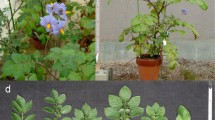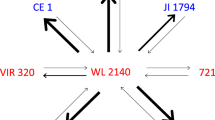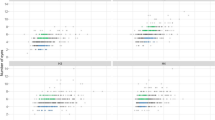Abstract
Large reciprocal differences were observed inSolanum tuberosum, when a mixed population of Group Phureja and Gp. Stenotomum was reciprocally crossed with a population of Gp. Tuberosum haploids. In the progeny reciprocal differences were observed for tuber initiation, tuber set, vine senescence, tuber yield, flowering, and male fertility. These differences were large in the F1 generation, but were less dramatic when the populations were inter-mated to form F2 generations. It is proposed that most of the reciprocal differences were due to a difference in photoperiod response in the reciprocal populations. Cytoplasmic inheritance or dauermodification are considered the most likely explanations for this difference in photoperiod reaction.
Resumen
Grandes diferencias recíprocas se observaron dentro deSolanum tuberosum, cuando poblaciones mistas del Grupo Phureja y del Grupo Stenotomum se cruzaron en for recíproca con una población de haploides del Grupo Tuberosum. Diferencias recíprocas en la progenie, se observaron para tuberización, senecencia del follaje, rendimiento de tubérculo, floración y fertilidad masculina. Estas diferencias fueron grandes en la generación F1, pero menos dramáticas cuando la generación F2 fue creada. Se propone que la mayoría de las diferencias recíprocas dentro de las poblaciones sea debido a diferencias en la reacción al fotoperíodo. Herencia cytoplásmica o “dauermodification” son consideradas como la explicación más probable para la diferencia en reacción al fotoperíodo.
Similar content being viewed by others
Literature Cited
Bodlaender, K.B.A. 1963. Influence of temperature, radiation, and photoperiod on development and yield, pp. 199–210.In The Growth of the Potato. Butterworths, London.
Chaplin, J.F. and Z.T. Ford. 1965. Agronomic and chemical characteristics of malesterile flue-cured tobacco as influenced by cytoplasm of differentNicotiana species. Crop Sci 5:436–438.
Estrada, R.N. 1978. Behavior ofSolanum curtilobum Juz et Buk in crosses to tetraploid cultivated potatoes. Am Potato J 55:374. (Abstr.)
Ewing, E.E. 1978. Critical photoperiods for tuberization: a screening technique with potato cuttings. Am Potato J 55:43–53.
Gour, V.K., and C.B. Singh. 1977. Influence ofAestivum wheat cytoplasm on hexaploid triticale. Can J Genet Cytol 19:187–188.
Grun, P. 1970. Changes of cytoplasmic factors during the evolution of the cultivated potato. Evolution 24:188–198.
Grun, P. 1973. Cytoplasmic sterilities that separate the Group Tuberosum cultivated potatoes from its putative tetraploid ancestor. Evolution 27:633–643.
Hoopes, R.W. 1978. Yield and fertility of reciprocal-cross hybrids of Tuberosum and Andigena potatoes. Ph.D. Thesis, Cornell University. 138 pp. Diss Abstrs 39:3087-B.
Hunter, R.B., and E.E. Gamblè. 1968. Effect of cytoplasmic source on the performance of double-cross hybrids in maize (Zea mays L.). Crop Sci 8:278–280.
Ivanova, O.A. 1974. Characteristics of development and tuber formation in cultivated and wild potato species in conditions of different photoperiods and temperature. Tr Prikl Bot Genet Sel 53(1): 148–162 (Ru. with En. summary).
Jollos, V. 1921. Experimentelle protisten Studien. I. Arcoh Protisienk 43:1–222.
Mendoza, H.A. and F.L. Haynes. 1977. Inheritance of tuber initiation in tuber bearingSolanum as influenced by photoperiod. Am Potato J 54:243–252.
Mok, D.W.S. and S.J. Peloquin. 1975. Breeding value of 2n pollen (diplandroids) in tetraploid × diploid crosses in potatoes. Theor Appl Genet 45:21–25.
Kalsy, H.S. and D. Sharma. 1972. Study of cytoplasmic effects in reciprocal crosses of divergent varieties of maize (Zea mays L.). Euphytica 21:527–533.
Khehra, A.S. and S.K. Blalla. 1976. Cytoplasmic effects on quantitative characters in maize (Zea mays L.). Theor Appl Genet 47:271–274.
Krug, H., G. Wriedt, and W.E. Weber. 1974. Investigations on early selection in potato breeding. Z. Pflanzenzucht 73:141–162.
Peloquin, S.J., and R.W. Hougas. 1959. Decapitation and genetic markers as related to haploidy inSolanum tuberosum. Eur Potato J 2:176–183.
Rowe, P.R. 1969. Nature, distribution, and use of diversity in the tuber-bearingSolanum species. Econ Bot 23(4):330–338.
Tarn, T.R. and G.C.C. Tai. 1977. Heterosis and variation of yield components in F1 hybrids between Group Tuberosum and Group Andigena potatoes. Crop Sci 17:517–521.
Went, F.W. 1959. Effects of environment of parent and grandparent generations on tuber production of potatoes. Am J Bot 46(4):277–282.
Author information
Authors and Affiliations
Additional information
Cooperative Investigation of Agricultural Research, Science and Education Administration, U.S. Department of Agriculture and the Wisconsin Agricultural Experiment Station.
Rights and permissions
About this article
Cite this article
Sanford, J.C., Hanneman, R.E. Reciprocal differences in the photoperiod reaction of hybrid populations inSolanum tuberosum . American Potato Journal 56, 531–540 (1979). https://doi.org/10.1007/BF02855968
Received:
Issue Date:
DOI: https://doi.org/10.1007/BF02855968




